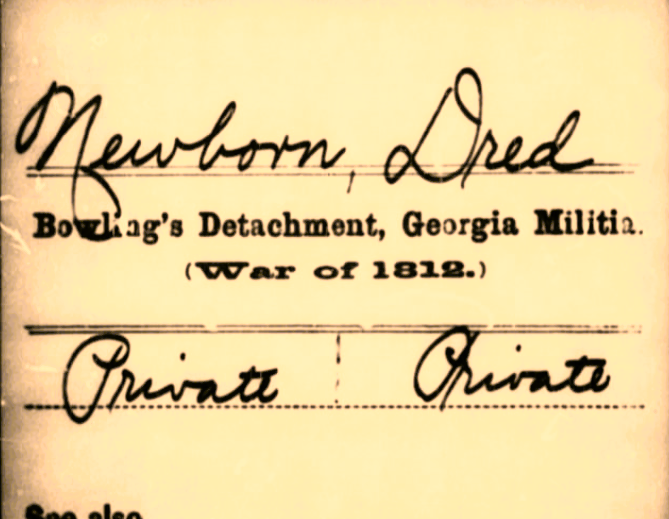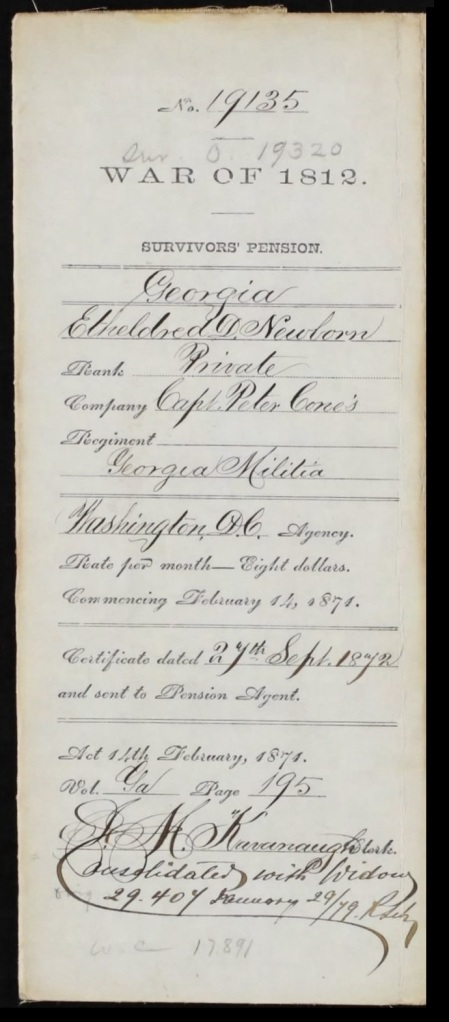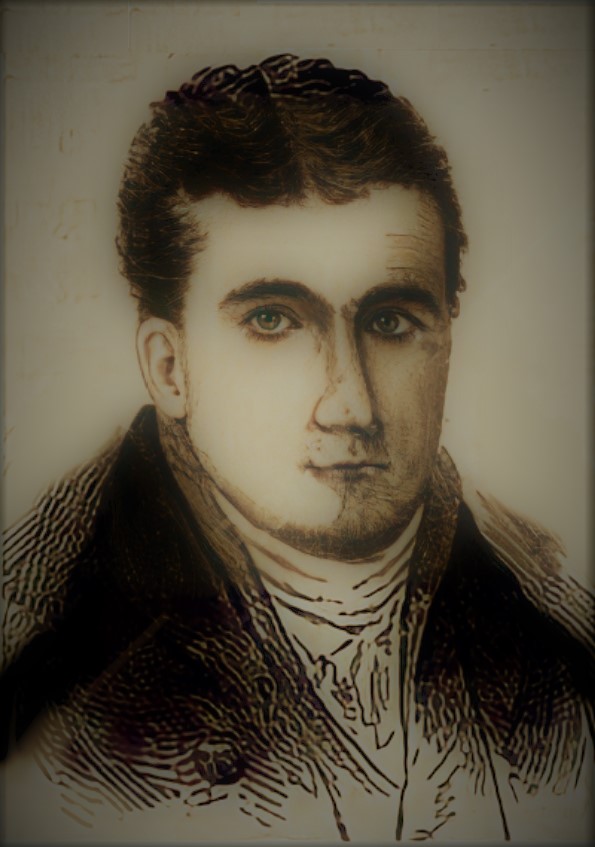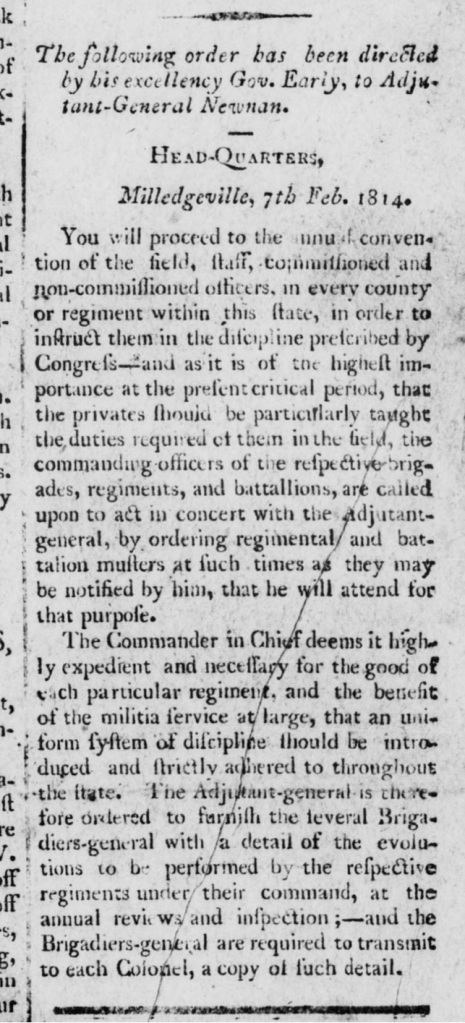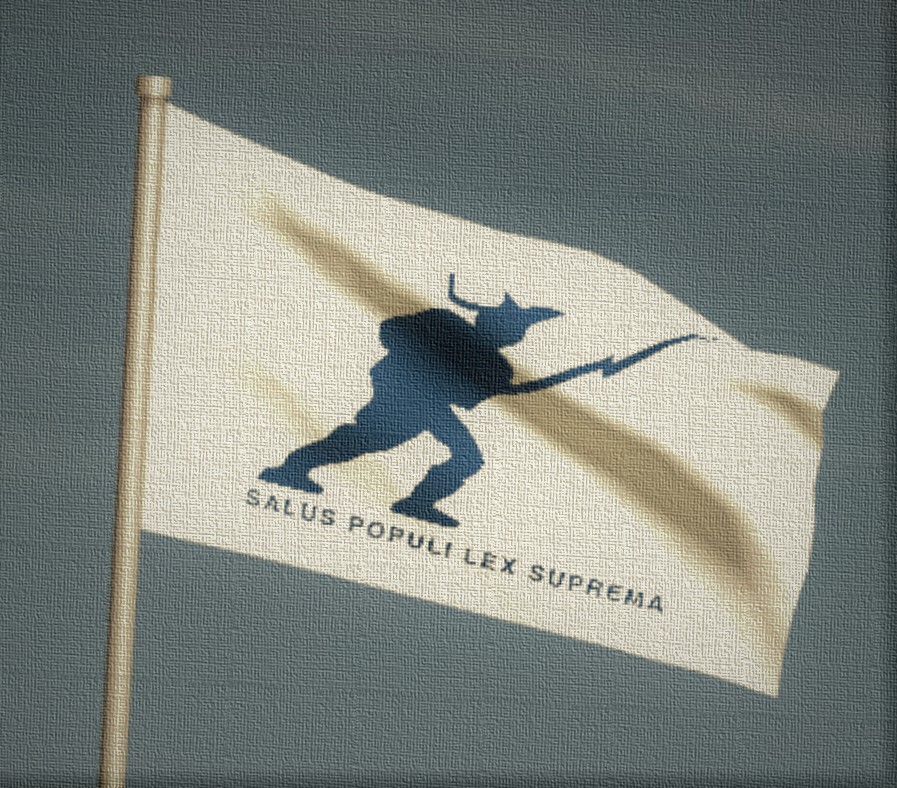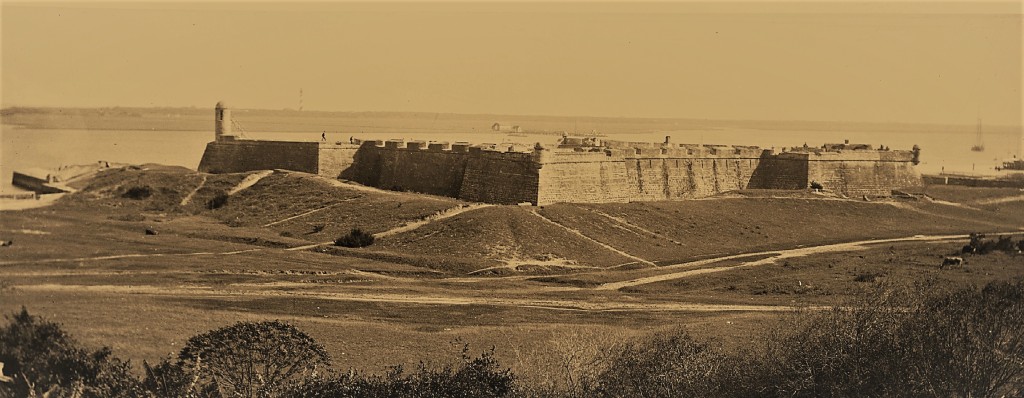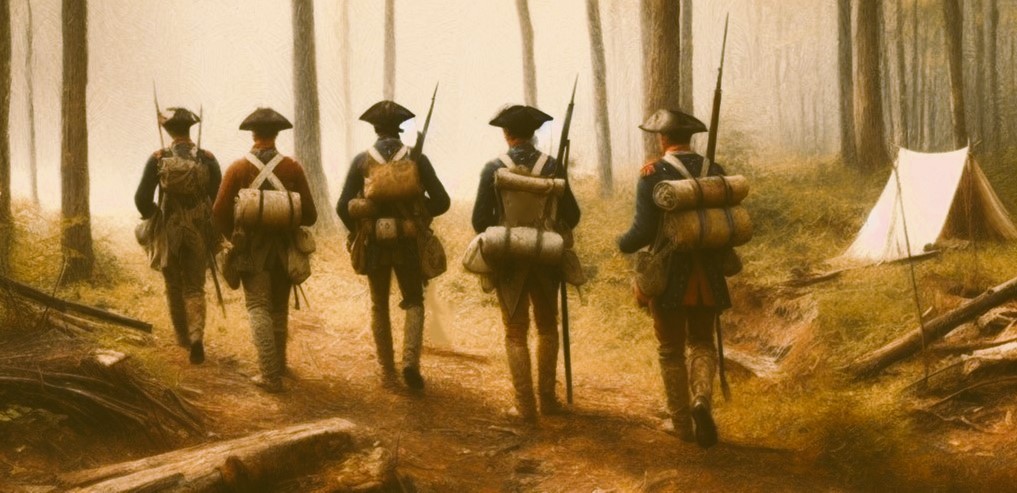War of 1812: Bowling’s Detachment
Etheldred “Dred” Newbern was a pioneer settler of Old Berrien County, Georgia.
During the War of 1812, while still residing in Bulloch County, GA, Dred Newbern was mustered into a Georgia Volunteer Militia company organized by Peter Cone. In the spring of 1814 Peter Cone’s Company was deployed on the coast of Georgia, first at Savannah then sent with Bowling’s Detachment (reconstructed roster below) to the seaport at Sunbury, GA. Sunbury, and other Georgia ports were then under blockade by the British fleet.
Peter Cone’s Company of Georgia Militia organized at Paramore’s Hill and marched to Savannah where, along with other Georgia militia companies they were mustered into a U.S. Army regiment commanded by Colonel Richard Manning. They were enlisted on March 26, 1814 and issued equipment.
From Manning’s Regiment, a detachment of three companies was formed and placed under the command of Major Robert Bowling. The three companies were led by Captain David Clarke, Captain Roger L. Gamble, and Lieutenant Peter Cone.
Bowling’s Detachment was ordered to March to Sunbury, GA south of Savannah to take up a station on the Midway River for the defense of the town. The maritime trade from Sunbury was threatened by the British frigate HMS Lacedemonian, which was anchored off Cumberland Island. Sunbury residents often saw the Lacedemonian’s armed launches in St. Catherine’s Sound, where they captured and burned American coastal vessels.
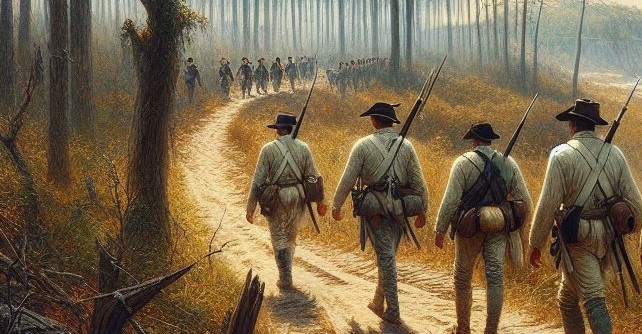
Bowling’s Detachment
| Name | Rank | Induction/Discharge |
|---|---|---|
| Bowling, Robert | Major | Induction: Major, Discharge: Major |
| Clarke, David | Capt | Induction: Capt, Discharge: Capt |
| Gamble, Roger L | Capt | Induction: Capt, Discharge: Capt |
| Bower, Benanuel | 1st Lt | Induction: 1 Lt, Discharge: 1 Lt |
| Cone, Peter | 1st Lt | Induction: 1 Lt, Discharge: 1 Lt |
| Meriwether, Alexander | 1st Lt | Induction: 1 Lt, Discharge: 1 Lt |
| Burke, Michael | 2nd Lt | Induction: 2 Lt, Discharge: 2 Lt |
| Marks, Leon H | 2nd Lt | Induction: 2 Lt, Discharge: 2 Lt |
| Rawls, John | 2nd Lt | Induction: 2 Lt, Discharge: 2 Lt |
| Clarke, James | 3rd Lt | Induction: 3 Lt, Discharge: 3 Lt |
| Gamble, John | 3rd Lt | Induction: 3 Lt, Discharge: 3 Lt |
| Hall, Thomas | 3rd Lt | Induction: 3 Lt, Discharge: 3 Lt |
| Elias, [Blank] | Servant | Induction: Servant, Discharge: Servant |
| Hannibal, [Blank] | Servant | Induction: Servant, Discharge: Servant |
| June, [Blank] | Servant | Induction: Waiter, Discharge: Servant |
| Lettuce, [Blank] | Servant | Induction: Waiter, Discharge: Servant |
| Boyd, James | Sgt | Induction: Sgt, Discharge: Sgt |
| Burns, William | Sgt | Induction: Sgt, Discharge: Sgt |
| Conner, James G | Sgt | Induction: Sgt, Discharge: Sgt |
| Gordon, James | Sgt | Induction: Cpl, Discharge: Sgt |
| Hagan, Joseph | Sgt | Induction: Sgt, Discharge: Sgt |
| Ladler, John | Sgt | Induction: Pvt, Discharge: Sgt |
| Lamp, Michael | Sgt | Induction: 1 Sgt, Discharge: Sgt |
| Langston, Seth S | Sgt | Induction: Cpl, Discharge: Sgt |
| Moore, Etheldred | Sgt | Induction: Sgt, Discharge: Sgt |
| Raifield, Alexander G | Sgt | Induction: Sgt, Discharge: Sgt |
| Rutledge, John | Sgt | Induction: Sgt, Discharge: Sgt |
| Shirley, William S | Sgt | Induction: Sgt, Discharge: Sgt |
| Stanaland, Richard | Sgt | Induction: Sgt, Discharge: Sgt |
| Waldron, John | Sgt | Induction: Sgt, Discharge: Sgt |
| Welch, Isaac | Sgt | Induction: Sgt, Discharge: 1 Sgt |
| Bigham, James | Cpl | Induction: Cpl, Discharge: Cpl |
| Bryan, Redding D | Cpl | Induction: Cpl, Discharge: Cpl |
| Fields, Miles | Cpl | Induction: Pvt, Discharge: Cpl |
| Fokes, Shadrach | Cpl | Induction: Pvt, Discharge: Cpl |
| Goodman, Henry | Cpl | Induction: Cpl, Discharge: Cpl |
| Grant, Thomas | Cpl | Induction: Cpl, Discharge: Cpl |
| Hichcock, Joseph | Cpl | Induction: Cpl, Discharge: Cpl |
| Hitchcock, Joseph | Cpl | Induction: Cpl, Discharge: Cpl |
| Jones, Tandy C | Cpl | Induction: Pvt, Discharge: Cpl |
| Lamp, Lewis | Cpl | Induction: Cpl, Discharge: Cpl |
| Scott, James | Cpl | Induction: Cpl, Discharge: Cpl |
| Stewart, Alexander | Cpl | Induction: Cpl, Discharge: Cpl |
| Chambers, John | Ensign | Induction: Ensign, Discharge: Ensign |
| Lovett, Cuyler | Ensign | Induction: Ensign, Discharge: Ensign |
| Crossley, Andrew | Artificer | Induction: Artificer, Discharge: Artificer |
| Darsey, Joseph | Artificer | Induction: Artificer, Discharge: Artificer |
| Kirk, Joseph | Artificer | Induction: Artificer, Discharge: Artificer |
| Marshall, John | Artificer | Induction: Pvt, Discharge: Artificer |
| Moore, Caswell | Artificer | Induction: Artificer, Discharge: Artificer |
| Salter, Edward T | Artificer | Induction: Artificer, Discharge: Artificer |
| Sample, James | Artificer | Induction: Artificer, Discharge: Artificer |
| Woods, John | Artificer | Induction: Artificer, Discharge: Artificer |
| Hall, John | Musician | Induction: Pvt, Discharge: Musician |
| Hendley, Thomas | Musician | Induction: Musician, Discharge: Musician |
| Miller, Seborn | Musician | Induction: Musician, Discharge: Musician |
| Sasser, Joseph | Musician | Induction: Pvt, Discharge: Musician |
| Sheppard, John B | Musician | Induction: Musician, Discharge: Musician |
| Starling, Starling | Musician | Induction: Musician, Discharge: Musician |
| Arrington, John | Pvt | Induction: Pvt, Discharge: Pvt |
| Arrington, William | Pvt | Induction: Pvt, Discharge: Pvt |
| Askew, Robinson | Pvt | Induction: Pvt, Discharge: Pvt |
| Baggs, John | Pvt | Induction: Pvt, Discharge: Pvt; Gamble’s Company |
| Baggs, William | Pvt | Induction: Cpl, Discharge: Pvt |
| Bailey, James | Pvt | Induction: Pvt, Discharge: Pvt |
| Baker, Asa | Pvt | Induction: Pvt, Discharge: Pvt |
| Bandy, Samuel | Pvt | Induction: Pvt, Discharge: Pvt |
| Bennet, James | Pvt | Induction: Pvt, Discharge: Pvt |
| Berryhill, Thomas | Pvt | Induction: Pvt, Discharge: Pvt |
| Best, Jacob | Pvt | Induction: Pvt, Discharge: Pvt; Cone’s Company |
| Best, William | Pvt | Induction: Pvt, Discharge: Pvt |
| Birch, John | Pvt | Induction: Pvt, Discharge: Pvt |
| Bird, Jas | Pvt | Induction: Pvt, Discharge: Pvt |
| Bird, John | Pvt | Induction: Pvt, Discharge: Pvt |
| Birt, John | Pvt | Induction: Pvt, Discharge: Pvt |
| Boatright, Reuben | Pvt | Induction: Pvt, Discharge: Pvt; Clarke’s Company |
| Boget, James | Pvt | Induction: Pvt, Discharge: Pvt |
| Bothwell, John W | Pvt | Induction: Pvt, Discharge: Pvt |
| Bowles, David | Pvt | Induction: Pvt, Discharge: Pvt |
| Bowles, David | Pvt | Induction: Pvt, Discharge: Pvt |
| Boyd, Baniah | Pvt | Induction: Pvt, Discharge: Pvt |
| Boyd, Stephen | Pvt | Induction: Pvt, Discharge: Pvt |
| Bracket, John | Pvt | Induction: Pvt, Discharge: Pvt |
| Bragg, William | Pvt | Induction: Pvt, Discharge: Pvt |
| Bryan, David | Pvt | Induction: Pvt, Discharge: Pvt |
| Butler, Charles | Pvt | Induction: Pvt, Discharge: Pvt |
| Carter, Jacob | Pvt | Induction: Pvt, Discharge: Pvt |
| Cato, William | Pvt | Induction: Pvt, Discharge: Pvt |
| Caulie, John | Pvt | Induction: Pvt, Discharge: Pvt |
| Caulie, Reason | Pvt | Induction: Pvt, Discharge: Pvt |
| Cobb, H | Pvt | Induction: Pvt, Discharge: Pvt |
| Cobb, James | Pvt | Induction: Pvt, Discharge: Pvt |
| Cobb, Rash | Pvt | Induction: Pvt, Discharge: Pvt |
| Cochran, Robert | Pvt | Induction: Pvt, Discharge: Pvt |
| Coleman, Isaac | Pvt | Induction: Pvt, Discharge: Pvt |
| Coleman, John | Pvt | Induction: Pvt, Discharge: Pvt |
| Coleman, Wade | Pvt | Induction: Pvt, Discharge: Pvt |
| Colliday, John | Pvt | Induction: Pvt, Discharge: Pvt |
| Conner, Isaac | Pvt | Induction: Pvt, Discharge: Pvt |
| Conner, William | Pvt | Induction: Pvt, Discharge: Pvt |
| Cook, Henry | Pvt | Induction: Pvt, Discharge: Pvt |
| Cook, John R | Pvt | Induction: Pvt, Discharge: Pvt |
| Cooper, Phineas | Pvt | Induction: Sgt, Discharge: Pvt |
| Coursey, Allen | Pvt | Induction: Pvt, Discharge: Pvt |
| Coward, J | Pvt | Induction: Pvt, Discharge: Pvt |
| Coward, J | Pvt | Induction: Pvt, Discharge: Pvt |
| Cravey, James | Pvt | Induction: Pvt, Discharge: Pvt |
| Crops, Samuel | Pvt | Induction: Pvt, Discharge: Pvt |
| Cunningham, John | Pvt | Induction: Pvt, Discharge: Pvt |
| Curle, Wilson | Pvt | Induction: Pvt, Discharge: Pvt |
| Davis, Joseph | Pvt | Induction: Pvt, Discharge: Pvt |
| Davis, Moses | Pvt | Induction: Pvt, Discharge: Pvt |
| Deal, Ferney | Pvt | Induction: Pvt, Discharge: Pvt |
| Deloach, William | Pvt | Induction: Pvt, Discharge: Pvt |
| Dokes, Campbell S | Pvt | Induction: Pvt, Discharge: Pvt |
| Donaldson, William | Pvt | Induction: Pvt, Discharge: Pvt |
| Drawdy, James | Pvt | Induction: Pvt, Discharge: Pvt |
| Drew, John | Pvt | Induction: Pvt, Discharge: Pvt |
| Driggers, Simeon | Pvt | Induction: Pvt, Discharge: Pvt |
| Emanuele, Amos | Pvt | Induction: Pvt, Discharge: Pvt |
| Evans, William | Pvt | Induction: Pvt, Discharge: Pvt |
| Ferrell, Charles | Pvt | Induction: Pvt, Discharge: Pvt |
| Fisher, William | Pvt | Induction: Pvt, Discharge: Pvt |
| Fleming, Laird B | Pvt | Induction: Pvt, Discharge: Pvt; Gamble’s Co. |
| Floyd, Joseph | Pvt | Induction: Pvt, Discharge: Pvt |
| Ford, John | Pvt | Induction: Pvt, Discharge: Pvt |
| Ford, Samuel | Pvt | Induction: Pvt, Discharge: Pvt |
| French, Charles | Pvt | Induction: Pvt, Discharge: Pvt |
| French, Rease | Pvt | Induction: Pvt, Discharge: Pvt |
| French, Robert | Pvt | Induction: Pvt, Discharge: Pvt |
| Gaines, Theophilus | Pvt | Induction: Pvt, Discharge: Pvt |
| Gardner, Aaron | Pvt | Induction: Pvt, Discharge: Pvt |
| Glass, Levy | Pvt | Induction: Pvt, Discharge: Pvt |
| Gooden, John | Pvt | Induction: Pvt, Discharge: Pvt |
| Gooden, Stephen | Pvt | Induction: Pvt, Discharge: Pvt |
| Gooden, Wiley | Pvt | Induction: Pvt, Discharge: Pvt |
| Goodman, Dennis | Pvt | Induction: Pvt, Discharge: Pvt |
| Goodman, William | Pvt | Induction: Pvt, Discharge: Pvt |
| Goodwin, John | Pvt | Induction: Pvt, Discharge: Pvt |
| Green, Daniel | Pvt | Induction: Pvt, Discharge: Pvt |
| Green, Elisha | Pvt | Induction: Pvt, Discharge: Pvt |
| Green, Lewis | Pvt | Induction: Pvt, Discharge: Pvt |
| Gregory, Samuel | Pvt | Induction: Pvt, Discharge: Pvt |
| Hadbury, Wilson | Pvt | Induction: Pvt, Discharge: Pvt |
| Ham, Aaron | Pvt | Induction: Pvt, Discharge: Pvt |
| Hammond, Daniel | Pvt | Induction: Pvt, Discharge: Pvt |
| Hand, Henry Harrison | Pvt | Induction: Pvt, Discharge: Pvt; Cone’s Company |
| Handbury, John | Pvt | Induction: Pvt, Discharge: Pvt |
| Handley, Thomas | Pvt | Induction: Pvt, Discharge: Pvt |
| Havens, Andrew | Pvt | Induction: Pvt, Discharge: Pvt |
| Hendrix, John | Pvt | Induction: Pvt, Discharge: Pvt |
| Herrington, Moses | Pvt | Induction: Pvt, Discharge: Pvt |
| Hiers, Solomon | Pvt | Induction: Pvt, Discharge: Pvt |
| Higgs, Jesse | Pvt | Induction: Pvt, Discharge: Pvt |
| Hilton, Jeremiah | Pvt | Induction: Pvt, Discharge: Pvt |
| House, William | Pvt | Induction: Pvt, Discharge: Pvt |
| Humphrey, Daniel | Pvt | Induction: Pvt, Discharge: Pvt |
| James, Mikel | Pvt | Induction: Pvt, Discharge: Pvt |
| Jeffers, John | Pvt | Induction: Pvt, Discharge: Pvt |
| Johnston, Elias | Pvt | Induction: Pvt, Discharge: Pvt |
| Johnston, Jared | Pvt | Induction: Pvt, Discharge: Pvt |
| Johnston, John | Pvt | Induction: Pvt, Discharge: Pvt |
| Jordan, David | Pvt | Induction: Pvt, Discharge: Pvt |
| Jordan, John | Pvt | Induction: Pvt, Discharge: Pvt |
| Kelly, John | Pvt | Induction: Pvt, Discharge: Pvt |
| Kemp, James | Pvt | Induction: Pvt, Discharge: Pvt |
| King, Wilson | Pvt | Induction: Pvt, Discharge: Pvt |
| Kirkland, McCullers | Pvt | Induction: Pvt, Discharge: Pvt |
| Lamb, Abraham | Pvt | Induction: Pvt, Discharge: Pvt |
| Lang, Robert | Pvt | Induction: Pvt, Discharge: Pvt |
| Lankford, William | Pvt | Induction: Pvt, Discharge: Pvt |
| Lee, Levi | Pvt | Induction: Pvt, Discharge: Pvt |
| Lewis, Nimrod | Pvt | Induction: Pvt, Discharge: Pvt |
| Long, Robert | Pvt | Induction: Pvt, Discharge: Pvt |
| Lovett, Thomas C | Pvt | Induction: Pvt, Discharge: Pvt |
| Mallory, James | Pvt | Induction: Pvt, Discharge: Pvt |
| Mallory, Thomas | Pvt | Induction: Pvt, Discharge: Pvt |
| Mason, John | Pvt | Induction: Pvt, Discharge: Pvt |
| Mathers, Isaac | Pvt | Induction: Pvt, Discharge: Pvt |
| McCullough, Jacob | Pvt | Induction: Artificer, Discharge: Pvt |
| McNelly, John | Pvt | Induction: Pvt, Discharge: Pvt |
| Metts, Redding | Pvt | Induction: Pvt, Discharge: Pvt |
| Miller, Joseph | Pvt | Induction: Pvt, Discharge: Pvt |
| Mims, David | Pvt | Induction: Pvt, Discharge: Pvt |
| Mitchell, John | Pvt | Induction: Pvt, Discharge: Pvt |
| Moore, Aldridge | Pvt | Induction: Pvt, Discharge: Pvt |
| Moore, Augustus | Pvt | Induction: Pvt, Discharge: Pvt |
| Morris, Moses | Pvt | Induction: Pvt, Discharge: Pvt |
| Morrison, William | Pvt | Induction: Pvt, Discharge: Pvt |
| Moy, Edwin | Pvt | Induction: Pvt, Discharge: Pvt |
| Nates, Zachariah | Pvt | Induction: Pvt, Discharge: Pvt |
| Newborn, Dred | Pvt | Induction: Pvt, Discharge: Pvt |
| Nobles, James | Pvt | Induction: Pvt, Discharge: Pvt |
| Norman, A. B. | Pvt | Induction: Pvt, Discharge: Pvt |
| Norman, James M | Pvt | Induction: Pvt, Discharge: Pvt |
| Norris, James | Pvt | Induction: Pvt, Discharge: Pvt |
| Olive, Benjamin | Pvt | Induction: Pvt, Discharge: Pvt |
| Olive, John | Pvt | Induction: Pvt, Discharge: Pvt |
| Overstreet, Stephen | Pvt | Induction: Pvt, Discharge: Pvt |
| Owens, Jesse | Pvt | Induction: Pvt, Discharge: Pvt |
| Parker, Starling | Pvt | Induction: Pvt, Discharge: Pvt |
| Patterson, William | Pvt | Induction: Pvt, Discharge: Pvt |
| Pierce, William | Pvt | Induction: Pvt, Discharge: Pvt |
| Pipkin, Uriah | Pvt | Induction: Pvt, Discharge: Pvt |
| Pomeroy, Samuel | Pvt | Induction: Pvt, Discharge: Pvt |
| Pye, James | Pvt | Induction: Pvt, Discharge: Pvt |
| Raiford, Robert | Pvt | Induction: Pvt, Discharge: Pvt |
| Rawls, Joseph | Pvt | Induction: Pvt, Discharge: Pvt |
| Reddy, David | Pvt | Induction: Pvt, Discharge: Pvt |
| Register, Josiah | Pvt | Induction: Pvt, Discharge: Pvt |
| Roberts, J | Pvt | Induction: Pvt, Discharge: Pvt |
| Robinson, Abram | Pvt | Induction: Pvt, Discharge: Pvt |
| Ross, William | Pvt | Induction: Pvt, Discharge: Pvt |
| Rowland, Nathan | Pvt | Induction: Pvt, Discharge: Pvt |
| Sample, William | Pvt | Induction: Pvt, Discharge: Pvt |
| Sanderlin, Owen | Pvt | Induction: Pvt, Discharge: Pvt |
| Scarbrough, Jackson | Pvt | Induction: Pvt, Discharge: Pvt |
| Scarbrough, Reddick | Pvt | Induction: Pvt, Discharge: Pvt |
| Schley, Michael | Pvt | Induction:1 Sgt, Discharge: Pvt |
| Scott, J | Pvt | Induction: Pvt, Discharge: Pvt |
| Scott, Robert | Pvt | Induction: Pvt, Discharge: Pvt |
| Shepherd, William | Pvt | Induction: Pvt, Discharge: Pvt |
| Simonson, Isaac | Pvt | Induction: Pvt, Discharge: Pvt |
| Smith, Daniel | Pvt | Induction: Pvt, Discharge: Pvt |
| Smith, Norris | Pvt | Induction: Pvt, Discharge: Pvt |
| Spence, Isaac | Pvt | Induction: Pvt, Discharge: Pvt |
| Spence, John | Pvt | Induction: Pvt, Discharge: Pvt |
| Stephens, Benjamin | Pvt | Induction: Pvt, Discharge: Pvt |
| Stone, Henry | Pvt | Induction: Pvt, Discharge: Pvt |
| Stone, Samuel | Pvt | Induction: Pvt, Discharge: Pvt Clarke’s Company |
| Stone, William | Pvt | Induction: Pvt, Discharge: Pvt |
| Streetman, William | Pvt | Induction: Pvt, Discharge: Pvt |
| Stringfellow, E | Pvt | Induction: Pvt, Discharge: Pvt |
| Sugs, Moses | Pvt | Induction: Pvt, Discharge: Pvt |
| Thornton, Redick | Pvt | Induction: Pvt, Discharge: Pvt |
| Trimble, John | Pvt | Induction: Pvt, Discharge: Pvt |
| Tyre, John | Pvt | Induction: Pvt, Discharge: Pvt |
| Tyre, Lewis | Pvt | Induction: Pvt, Discharge: Pvt |
| Vickery, William | Pvt | Induction: Pvt, Discharge: Pvt |
| Walden, Samuel | Pvt | Induction: Pvt, Discharge: Pvt |
| Walters, William | Pvt | Induction: Pvt, Discharge: Pvt |
| Walton, Daniel | Pvt | Induction: Pvt, Discharge: Pvt |
| Walton, David | Pvt | Induction: Pvt, Discharge: Pvt |
| Waters, George | Pvt | Induction: Pvt, Discharge: Pvt |
| Waters, William | Pvt | Induction: Pvt, Discharge: Pvt |
| Webb, Willie | Pvt | Induction: Pvt, Discharge: Pvt |
| Wester, Henry | Pvt | Induction: Pvt, Discharge: Pvt |
| Whiddon, William | Pvt | Induction: Pvt, Discharge: Pvt |
| White, William | Pvt | Induction: Pvt, Discharge: Pvt |
| Wilde, David | Pvt | Induction: Pvt, Discharge: Pvt |
| Wilkerson, James | Pvt | Induction: Pvt, Discharge: Pvt |
| Williams, John | Pvt | Induction: Pvt, Discharge: Pvt |
| Woods, William | Pvt | Induction: Pvt, Discharge: Pvt |
| Wren, William | Pvt | Induction: Pvt, Discharge: Pvt |
| Wright, Moses | Pvt | Induction: Pvt, Discharge: Pvt |
